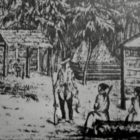Apalachicola Tribe
Apalachicola Tribe
From Hitchiti “Apalachicoli” or Muskogee “Apalachicolo,” signifying apparently “People of the other side,” with reference probably to the Apalachicola River or some nearby stream.
Also called:
- Talwa lako or Italwa lako, “big town,” name given by the Muskogee Indians.
- Palachicola or Parachukla, contractions of Apalachicola.
 The earliest known home of the Apalachicola Tribe was near the river which bears their name in the center of the Lower Creek country. Later they lived for a considerable period at the point where it comes into existence through the junction of the Chattahoochee and Flint Rivers.
The earliest known home of the Apalachicola Tribe was near the river which bears their name in the center of the Lower Creek country. Later they lived for a considerable period at the point where it comes into existence through the junction of the Chattahoochee and Flint Rivers.
In 1715 just before the outbreak of the Yamasee war, there were said to be 2 settlements of this tribe with 64 warriors and a total population of 214. A Spanish census of 1738 also gave 2 settlements with 60 warriors in one and 45 in the other; a French census of 1750, more than 30 warriors; a British enumeration of 1760, 60; one of 1761, 20; an American estimate of 1792, 100 (including the Chiaha); and the United States Census of 1832, a total population of 239 in 2 settlements.
According to Muskogee legend, the ancestors of the Muskogee encountered the Apalachicola in the region above indicated, when they entered the country, and they were at first disposed to fight with them but soon made peace. According to one legend the Creek Confederacy came into existence as a result of this treaty. Spanish documents of the seventeenth century are the earliest in which the name appears. It is there used both as the name of a town (as early as 1675) and, in an extended sense, for all of the Lower Creeks. This fact, Muskogee tradition, and the name Talwa Iako all show the early importance of the people. They were on more friendly terms with the Spaniards than the Muskogee generally and hence were fallen upon by the Indian allies of the English and carried off, either in 1706 or 1707. They were settled on Savannah River opposite Mount Pleasant, at a place which long bore their name, but in 1716, just after the Yamasee war, they retired into their old country and established themselves at the junction of Chattahoochee and Flint Rivers. Later they moved higher up the Chattahoochee and lived in Russell County, Alabama, remaining in the general neighborhood until they removed to new homes in the present Oklahoma in 1836-40. There they established themselves in the northern part of the Creek Reservation but presently gave up their ceremonial ground and were gradually absorbed in the mass of Indians about them.
